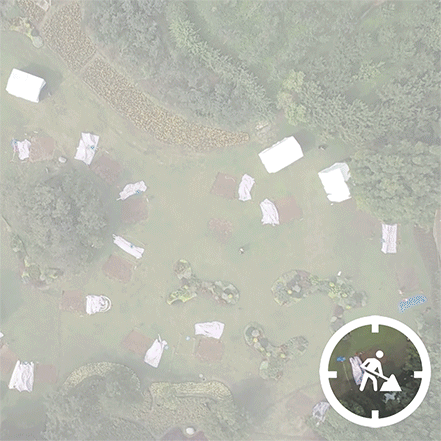本文由 同济原作设计工作室 授权mooool发表,欢迎转发,禁止以mooool编辑版本转载。
Thanks Original Design Studio, TJAD for authorizing the publication of the project on mooool, Text description provided by Original Design Studio, TJAD.
同济原作设计工作室:对于在公园草坪上开展的竹构建造,我们原本担心若仍从竹子本体的形态、受力出发来做设计难有新意,为已经几乎穷尽了各种形式的竹构操作添上可有可无的一笔。几经推敲后,我们意识到可以借此契机做一个充满“生命之初”意向的、摇摆不定的、充满游戏氛围的小场域。
Original Design Studio, TJAD: For this bamboo pavilion situated among the greens of the park, we felt that starting from the form and structural principles of the bamboo material may end up in adding another seemingly novel but rather routine design to the already much explored field of bamboo constructions. Instead, we decided to create a site that is almost primitive, intentionally unstable and interactive in a playful way.
方案底部为三组共九根原竹交织而成的近球形底面,中部由三组交叉的竹竿连接,既确保了底座结构的稳定,又作为长椅供人使用。竹竿向外伸出的六组,翘起的三组较长,为主要使用座椅,余下三组较短,在摇篮晃动幅度较大时向下支撑地面,防止倾覆,提供安全保障。
The structure sits on a spherical base formed by nine bent bamboo sticks arranged in three intersecting groups. The base is then fastened in the middle part by three corresponding sets of bamboo beams, which holds the bent bamboos in place and serves as benches. These horizontal members extend beyond the spherical base on both ends. The longer extension points up to become seats, while the shorter extension on the other end points down to meet the ground, providing supports to keep the tilting of the structure within safety limits.
▽场地分析 Site analysis
▽轴测分解 Axonometric decomposition
▽使用分析 Analysis of usage
最初顶部的设计理念是由多根原竹劈开的竹篾交织,圈圈相连,轴线规整,营造出轻盈而茂盛的几何密林。施工过程中,因为竹材柔韧以至平面出现偏移,在原方案的规整平面上进行调整,又因现场施工工艺限制,最终调整为由竹管伸出的一个个竹圈相互连接,呈现出平面逻辑均质,而视觉上又有着随机层次感的作品。
The top of the structure was designed to be interwoven bamboo strips, which is made by splitting the end of the bamboo sticks into several smaller threads. The threads should form rings that follow the axial directions of the main structural elements, resulting in a light but visually dense geometrical system. However, during construction, the resistance of the bamboo material caused disturbance to the plan. Hence, the design is altered on-site to fit the reality of material and limitation of construction. The naturally split bamboo strips are switched to additional bamboo rings attached to the main pieces. They are overall aligned evenly to the structural grid but create visual complexity due to the slight partial disturbance and misalignment resulting from the material’s properties.
▽半掩在花园里的竹编摇篮 A bamboo cradle half-hidden in the garden
▽顶部以圈圈相连的竹篾交织而成 Loop connected top design
▽原竹交织而成的近球形底面 The subspherical underside of the interwoven bamboo
摇篮的设计在场地上有着容纳各方游者的优势,白色碎石将三条引导游人使用摇篮的路径点明,不同方向的来人可以交汇于这个半掩在花园里的摇篮上。碎石将场地分为三个部分,是以将花园定为与竹构形态相呼应的三组球状植物簇拥而成的“丛林”。中间由球形小蜡、蓝冰柏、亮晶女贞棒棒糖等较高植株点睛,向外布置灯芯草、百子莲、粉黛乱子草、蒲苇和茅草等较矮植株,再以低矮垂地的绣球、蓝雪花、芒草、矾根和飞蓬草等向外蔓延。
The site is arranged to greet visitors from all directions. The pebbled path leads to the three seats, giving hint for how the structure could be used, and draws attention to the cradle camouflaged by shrubs. The gravel path divides the bushes into three parts, corresponding to the three groups of structural bamboos. Towards the center are several taller species of privets and cypress plants, then lowering to soft rush, African lily, muhly grass, pampas grass, satintail, finally phasing out to ground level bushes like hydrangea, ceratostigma, miscanthus, crevice alumroot and erigeron.
▽人与自然与竹构间的活力相融 The dynamic integration between man and nature and bamboo structure
多人分坐受力不均使得构筑物在花海间旋转摇晃,细密的顶部密林也随之悠悠摇曳,让人、竹构与自然三者活力相融。它从场所与活动出发以延伸竹构的意义,最大限度强化了竹的韧性特征,并使之成为人与人关系的某种映射——在“摇篮”中创造出一个非“非必要”的面对面交流的机会,让摇篮成为触动人与人、人与自然互动的媒介。
The cradle turns and wobbles when occupied, creating gentle rustlings on the top bamboo mesh. It establishes an intimate connection between human, architecture and the nature. The cradle examines the bending nature of bamboo materials from the perspective of site and human interactions. The project is a way of materializing our social desires – the desire to create an unexpected chance of communication, a media for interacting with others and the nature.
▽施工过程 Process of construction
项目名称:2022年成都公园城市国际花园季暨第五届北林国际花园建造周设计师组作品——摇篮
建筑事务所:同济大学建筑设计研究院(集团)有限公司原作设计工作室
电邮联系方式:zmz3388@126.com
主办单位:中国风景园林学会教育工作委员会、成都市公园城市建设管理局、北京林业大学园林学院、成都市博览局
主创建筑师:章明、张姿
建筑设计团队:秦曙 丁歆 羊青园 刘静怡 王雨晴 毕心怡
技术支持:安吉竹境竹业科技有限公司
项目地点:成都植物园大草坪
建筑面积:16平方米
建成时间:2022年7月
Project Name: The Cradle – A design for the ‘2022 Chengdu Garden City International Gardening Festival + the Fifth Beilin International Landscape Construction Week’
Architect: Original Design Studio/TJAD
Contact E-mail: zmz3388@126.com
Curation: Chinese Society of Landscape Architecture, Chengdu Garden City Construction Management Bureau, Beijing Forestry University School of Landscape Architecture, Chengdu Exhibition Bureau
Leading Architects: Zhang Ming, Zhang Zi
Architecture Design Team: Qin Shu, Ding Xin ,Yang Qingyuan, Liu Jingyi, Wang Yuqing, Bi Xinyi
Technical Support: Anji Zhujing Bamboo Ltd.
Location: Chengdu Botanical Garden
Area of building: 16 square meters.
Date of construction: July 2022
“ 以原野上的竹编摇篮,构建一个充满“生命之初”意向的、摇摆不定的、充满游戏氛围的小场域。”
审稿编辑:Maggie
更多 Read more about:同济原作设计工作室
















0 Comments